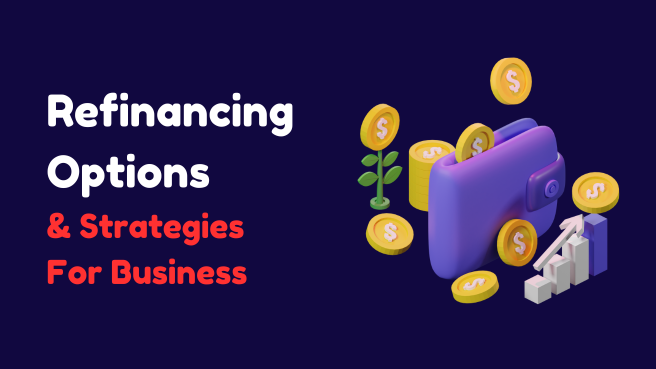In today’s rapidly evolving economic landscape, businesses of all sizes constantly seek ways to optimize their financial operations and enhance sustainability. Refinancing existing debts or reevaluating financial strategies can offer significant benefits, including reduced costs, improved cash flow, and better terms of service. This comprehensive guide delves into various refinancing options and strategies that businesses can employ to navigate financial complexities effectively.
Understanding Refinancing
Refinancing involves replacing an existing debt with a new loan under different terms. This strategic financial decision is often undertaken to take advantage of better interest rates, extend repayment terms, or consolidate multiple debts into a single loan. For businesses, refinancing is a tool not just for managing debt, but also for freeing up operational cash, investing in growth opportunities, and stabilizing financial health in fluctuating markets.
Key Refinancing Options for Businesses
1. Traditional Bank Loans
Traditional bank loans are a common source for refinancing business debt. These loans often offer competitive interest rates and terms which can be more favorable than the original loans. By refinancing through a bank, businesses may reduce their monthly payments or shorten the loan term, which can lead to significant interest savings over time.
2. Small Business Administration (SBA) Loans
SBA loans are partially guaranteed by the U.S. Small Business Administration, making them a viable option for small businesses that might not qualify for traditional bank loans. Refinancing through SBA loans can provide businesses with lower interest rates and longer repayment terms, thus enhancing their ability to manage cash flow more effectively.
3. Bond Issuance
Large corporations may opt to issue bonds as a refinancing strategy. By issuing bonds, companies can access capital from a broad pool of investors at fixed interest rates, which can often be lower than the rates on bank loans. This option is particularly attractive in a low-interest-rate environment.
4. Online Lenders
Online lenders offer a quicker, more flexible approach to refinancing. While their rates may be higher than those of traditional banks, they often provide faster approval processes and less stringent requirements, which can be crucial for businesses needing immediate financial relief.
Strategies for Effective Refinancing
Assessing Financial Health
Before considering refinancing, it’s vital for businesses to thoroughly assess their financial situation. This includes reviewing their debt-to-income ratio, credit score, and overall financial performance. A solid understanding of where the business stands financially will help in choosing the most beneficial refinancing option.
Timing the Market
Interest rates fluctuate based on economic conditions. Monitoring these trends can allow businesses to refinance when rates are lowest, maximizing their savings and potentially improving loan terms.
Debt Consolidation & Personal Loan
For businesses juggling multiple debts, consolidating them into a single loan can simplify financial management and reduce costs. This approach often involves taking out a new loan to pay off various others, ideally at a lower interest rate, which can significantly decrease the amount paid monthly.
Negotiating with Lenders
Don’t hesitate to negotiate with potential lenders for better terms. Whether it’s a lower interest rate, a longer repayment period, or both, effective negotiation can lead to substantial savings and a more favorable financial position.
Leveraging Financial Advisors
Working with financial advisors or consultants can provide businesses with insights and guidance tailored to their specific needs. These professionals can help identify the best refinancing options and strategies, navigate the application process, and optimize financial restructuring.
Real-Life Statistics and Data
According to the Federal Reserve, the average interest rate for commercial and industrial loans has fluctuated significantly over the past decade, highlighting the importance of timely refinancing to capitalize on lower rates. Furthermore, a report by the U.S. Small Business Administration noted that small businesses that refinanced their loans through the SBA 504 program saved an average of 15% on interest payments.
Maximizing Benefits Through Strategic Refinancing Decisions
Refinancing is not just about reducing interest rates; it’s about aligning financial strategies with business objectives to foster long-term success. Businesses need to consider not only the immediate financial impact of refinancing but also how it fits into their broader financial strategies.
Prioritizing Objectives
The first step in a strategic refinancing effort is to clearly define what the business aims to achieve through the process. Whether the goal is to reduce monthly payments, change the loan term, or consolidate debts, having clear objectives will guide the decision-making process and help identify the most appropriate refinancing options.
Analyzing Cash Flow
Refinancing can significantly affect a business’s cash flow. By reducing monthly payments, companies can free up cash for other operational needs or investment opportunities. It’s crucial to perform a detailed cash flow analysis before deciding to refinance, ensuring that the new loan structure supports the company’s ability to generate revenue and meet its financial obligations.
Considering Costs
Refinancing usually involves various costs such as application fees, origination fees, and possibly prepayment penalties on the old loan. It’s essential to calculate these costs to determine the total expense of refinancing and assess whether the long-term savings justify these upfront expenses. Sometimes, the costs associated with refinancing might outweigh the benefits if not properly managed.
Long-term Impact
The impact of refinancing extends beyond immediate financial relief. It can influence a company’s credit rating and its relationships with lenders. Positive refinancing, which leads to timely debt repayments, can enhance a company’s creditworthiness, making it easier to secure financing in the future at even better rates. Conversely, refinancing that results in terms that are not sustainable could harm a company’s financial stability and credit standing.
Case Studies: Successful Refinancing
Looking at real-world examples, many businesses have successfully leveraged refinancing to propel their growth and stability. For instance, a mid-sized manufacturing company was able to reduce their interest expense by 20% annually by refinancing their old high-interest loans during a period of low-interest rates. This significant reduction in interest payments allowed them to reinvest in core business operations, leading to increased production capacity and revenue growth.
Another example is a small retail chain that used debt consolidation to simplify their financial obligations and reduce administrative overhead. By consolidating multiple loans into one with a lower overall interest rate, they improved their monthly cash flow, which provided more liquidity to fund expansion into new markets.
Future-Proofing Through Adaptive Refinancing
In an unpredictable economic environment, businesses must remain adaptive in their financial strategies, including refinancing. Staying informed about economic trends, regulatory changes, and advancements in financial services will enable businesses to take advantage of new opportunities as they arise.
Utilizing Technology
Technological advancements in financial services, such as automated loan management systems and fintech solutions, can facilitate more effective refinancing. These tools offer businesses enhanced data analysis capabilities, better loan terms comparison, and streamlined application processes, making it easier to manage refinancing efficiently.
Continuous Learning
Ongoing education about financial management practices and refinancing options is vital. Business leaders should regularly engage in learning opportunities, such as seminars, workshops, or courses, to stay updated on the best practices and emerging trends in financial management.
Conclusion
Refinancing is a critical strategy for businesses aiming to maintain or improve their financial health. By understanding the various options available, focusing on strategic goals, and engaging with the right financial partners, businesses can effectively use refinancing to manage debt, improve cash flow, and invest in growth opportunities. With careful planning and a proactive approach, refinancing can provide a robust foundation for future financial success, ensuring that businesses not only survive but thrive in today’s competitive marketplace.



